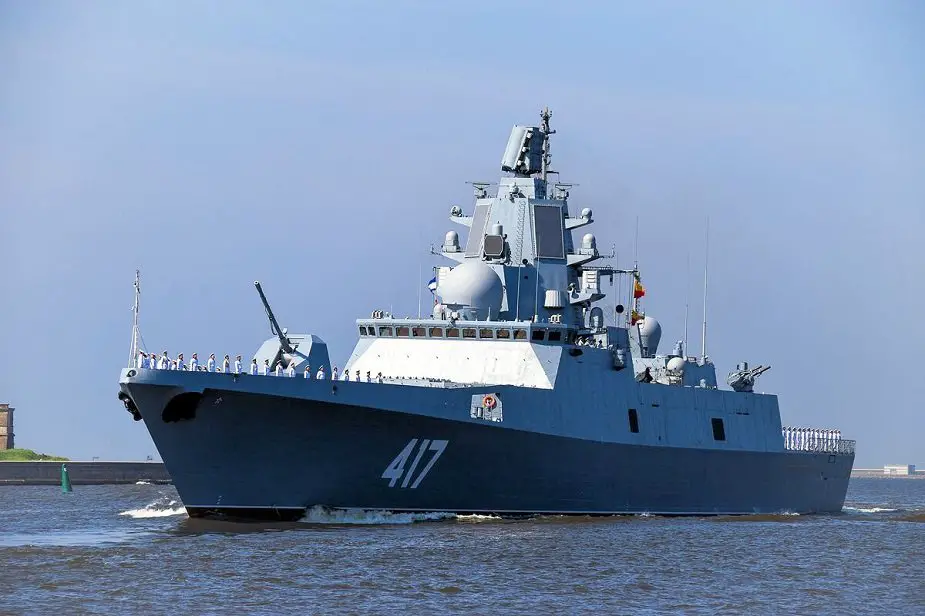Russia is resuming the construction of blue and green-water warships after a long break. Expert Alexander Shishkin writes about the warships and their strength in the Vzglyad business newspaper.
 Frigate Admiral Gorshkov during the Naval Day parade in Kronshtadt (Picture source: TASS)
Frigate Admiral Gorshkov during the Naval Day parade in Kronshtadt (Picture source: TASS)
The two modernized frigates of project 22350 to be laid by Severnaya Verf Shipyard are upgraded with three universal vertical launchers for 24 missiles. They are similar to Admiral Amelko and Admiral Chichagov laid on April 23, 2019. The creation of upgraded project 22350M frigates is at the stage of rough design. The first steel for the lead warship will be cut not earlier than in 2021. The doubled 22350 series (from four to eight warships) is a major step in restoring the blue-water force.
After the Soviet collapse, the Russian Navy remained without blue-water warships which were classified then as patrol escorts. When the Admiral Grigorovich frigate of project 11356 joined the Navy in 2016, it had only five patrol escorts and three of them were of the post-war generation. There were 47 of them in 1991.
The first attempt to revive the class was cut short halfway. Ukrainian sanctions on gas turbine engines stripped the Black Sea fleet of six projects 11356 frigates. The series could be expanded to 12 and more ships, but the fleet received only three.
The second attempt is ongoing and will likely be successful. At least ten frigates of project 22350 have to be laid. The Northern and Pacific fleets have to get six warships each and the Baltic and the Black Sea fleets - three each.
The laying of corvettes after a four-year break is good news if they are not of project 20386. Its drawbacks include excessively big size (full displacement of 3400 tons), lack of arms (Uran anti-ship missiles and weak acoustics), helicopter hangar under the deck which occupies the precious impermeable space, too sophisticated power plant, excessive construction cost close to the price of project 22350 frigate, excessive operational costs due to additional modules with servicing personnel, excessive innovations which make it adventurous to launch batch production before trials and test operation of the lead ship are completed.
A reasonable alternative to project 20386 is the well-tested basic project 20380, but with better electronic weapons. At present four warships are built: two by Severnaya Verf and two by Amur Shipyard. The main drawback of project 20380 is weak missile arms represented by Uran with eight light subsonic tactical 3M-24 (Kh-35) missiles.
Another alternative is project 20385 corvettes (one tested and another in the slipway). They are armed with Kalibr missiles but have another drawback. The power-weight ratio is smaller because of the use of the same power plant in a bigger displacement (6-14 per cent by various data). It will decrease the speed of one-two knots. The problem can be resolved by the higher power of 1DDA12000 machine if Kolomna plant receives a technical assignment from the Navy for the corresponding R&D.
The news about a potential laying of two universal amphibious assault ships in Crimean Kerch in May 2020 raises doubts. Firstly, even if the technical assignment is ready in late 2019, only five months would remain to approve the technical project which is necessary to launch the construction. It is an impossible task.
Secondly, the technical characteristics of the landing ships (15000-ton displacement and ten helicopters) leave much to be desired. All foreign analogues have a much bigger displacement: South Korean Tokto - 19300 tons, French Mistral - 22000 tons, Spanish Juan Carlos I - 27500 tons, and the recently floated Italian Trieste - 33000 tons to say nothing of the US and Chinese universal assault ships under construction with a displacement of 40000 to 45000 tons. Russia is a great sea power and cannot lag behind the United States and China, as well as France, South Korea, Italy, Australia, Spain, Turkey and Egypt.
The universal landing ships might have been confused with helicopter-carrying docks. The project of one of it was displayed at Army-2019. It had a similar displacement of 14000 tons and small airpower of four-six Ka-27 and Ka-52K.
Despite all the mentioned problems, it is clear that the Defense Ministry and the military-industrial complex are thinking not about solo warships, but groups of similar ships. The USC 2019 report mentions "group formation" and "group reinforcement" five times. In other words, there is hope that the long-term military shipbuilding program (or blue and green-water fleet) will be implemented sooner or later, expert Alexander Shishkin writes in the Vzglyad business newspaper.



